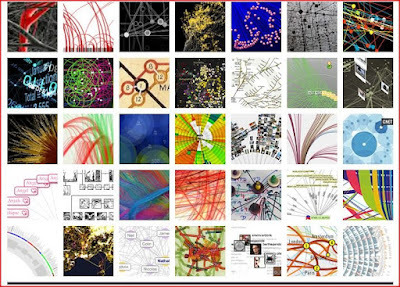Why? Interactive duo and multi-touch interfaces are becoming more common, and now come in all sizes of screens, from the iPhone, the Surface, and CNN's multi-touch "Magic Wall". People of all ages play interactive games on the Wii, often on large flat-panel displays. In my opinion, the time is right for those developing applications for the InfoViz world to think about harnessing the power of multi-touch.
Below is a picture of the front page of the Visual Complexity website. If you go to the site, you can select a visualization, and then explore it more in detail, as each picture links to a web-page that provides background information about the visualization project, the artist or team behind the project, and links to the project's website.
I took a look at a variety of the examples posted on the Information Complexity website, and think many would be enhanced by a transformation to a multi-touch, gesture, bi-manual, or duo/multi user system. I'm interested in learning what others think about this. If you are working on a collaborative information visualization project, feel free to add a comment and post a link.
Here is a a nice quote from the website:
| "Functional visualizations are more than innovative statistical analyses and computational algorithms. They must make sense to the user and require a visual language system that uses colour, shape, line, hierarchy and composition to communicate clearly and appropriately, much like the alphabetic and character-based languages used worldwide between humans." Matt Woolman |
Update: I did a search for "multi-touch" on the Visual Complexity website and found a couple of interactive applications:
Reactable (I've posted about this system a few times!)
(Reactable website)











1 comment:
1/11/11: Now that we have Kinect, I wonder how this will play out?
Post a Comment